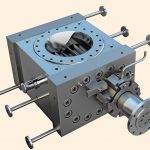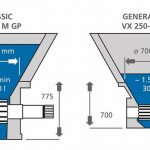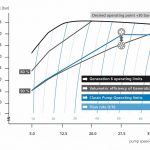Components that are capable of discharging low and high-viscosity plastic melts gently from reactors and degassing systems are essential in polymer processes. External gear pumps have become first choice due to their reliability and volumetric consistency. Maag gear pumps of the sith generation (x6 class) now feature a completely redesigned interior with a wide pressure and viscosity-handling window, small footprint and high energy efficiency.
External gear pumps with completely redesigned interior
Sixth generation breaks traditional laws
Components that are capable of discharging low and high-viscosity plastic melts gently from reactors and degassing systems are essential in polymer processes. External gear pumps have become first choice due to their reliability and volumetric consistency. Maag gear pumps of the sith generation (x6 class) now feature a completely redesigned interior with a wide pressure and viscosity-handling window, small footprint and high energy efficiency.
Gear pump technology is several decades old and the shaft and bearing geometries are well-defined. Despite that, Rene Triebe, Senior Engineering Expert at Maag Pump Systems AG, couldn’t shake the feeling that while the gear pump was doing its job, its basic design wasn’t as fine-tuned as it could be, impacting on the pump’s overall performance and efficiency. Maag experts therefore spent a lot of time discussing improvements to various aspects of the gear pump. “We found out that if we change the geometry adjacent to the gears locally, we get a completely different volumetric efficiency”, Triebe recalls. “We also discovered that by doing this we could make the pump smaller, yet still deliver higher flow rates. We had broken the traditional laws of gear pump operation. We had a new basic equation when it came to the performance of the gear pump, which gave us totally new opportunities.”
Inlet section widened
That innovation is meanwhile known as the x6 class gear pump, which features a completely redesigned interior, from the gear wheels and shaft to the bearings and seals. The result is a gear pump that rotates faster and can fill better from the inlet. In the past, the liquid had to converge at the gear pump inlet, which represented a significant flow restriction – especially in applications where the pump is used to extract polymer from a vessel or reactor under vacuum. This narrow section has been made wider and the flow more evenly distributed. The polymer can now be sucked in much better than with the classical design.
Also, since high-viscosity liquids create considerable friction, users habitually adapted the gaps in the bearing area to the specific viscosity range, although the basic design has stayed the same. Owing to the much higher inherent efficiency, the gaps in the bearing area of the x6 class pump could be enlarged to allow a higher speed without compromising efficiency or operational safety. Higher efficiency not only saves energy but simultaneously increases the overall throughput, as less material needs to be pumped twice.
Thanks to the thicker bearing sleeve, the x6 class pump can handle loads that require higher pumping pressure. At high pressures, gear pumps experience some bending of the shaft, which will result in undesirable metal-to-metal contact with the bearings if they are operated above the design limits. The x6 class pump has a thicker shaft which enables higher loads (pressures) until this point is reached. This – and the improved efficiency – means that the x6 class pump can operate very effectively with low-viscosity products, even at higher pressures in the 200 to 250 bar range.
Moreover, because the pump cross-section at the inlet – which at the level of the gear teeth is always a rectangle – is closer to a circle, the hydraulic diameter is optimised and flow restrictions are reduced.
Higher flow rates
Another benefit is that, since the x6 class pumps are more efficient, they require less power to operate. Consuming less energy also allows polymer producers to claim that their operations are more environmentally sensitive. The two drivers of increased energy efficiency are not pumping as much twice by lowering the recirculation rate and having fewer frictional surfaces that create unnecessary losses. The most eye-opening aspect of the x6 class pump, however, might be the fact that, despite its smaller size, it is able to deliver higher flow rates – which the classic performance curves say should really be impossible.
“The compact design is interesting in that the x6 class pump can have a capacity 30 % to 50 % higher than other gear pumps of the same size”, says Triebe. “The old mindset was that a certain pump size had to be linked to a certain flow rate. You could tweak it 5 % here or there, but you wouldn’t be changing the rules. Delivering a 30 % to 50 % increase in flow rate is breaking all the rules.” The charts illustrate how the x6 class pump overcomes the traditional rules of gear pump operation.
Hall 9, Booth A4
www.cpp-net.com search: cpp0316maag
Manfred Waeckerlin
Manfred Waeckerlin
Director Pumps,
Maag
Share:










